ASUS Zenbook Prime (UX21A) Review: The First of the 2nd Gen Ultrabooks
by Anand Lal Shimpi on May 22, 2012 2:46 PM EST- Posted in
- Laptops
- CPUs
- Asus
- Ivy Bridge
- Zenbook
- Zenbook Prime
- Ultrabook
- Notebooks
GPU Performance
Peak synthetic GPU performance sees a sizeable boost compared to the previous generation Zenbook. 3DMark 11 requires DX11 hardware and thus the original Zenbook won't run on it, but the rest of the 3DMark tests give us some perspective.
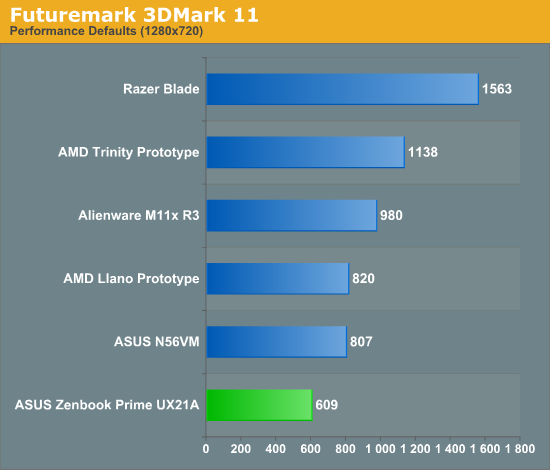
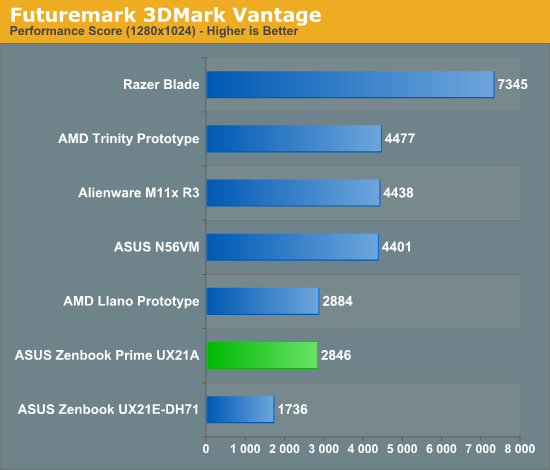
Vantage shows us a 63% improvement over the HD 3000 based Zenbook UX21.
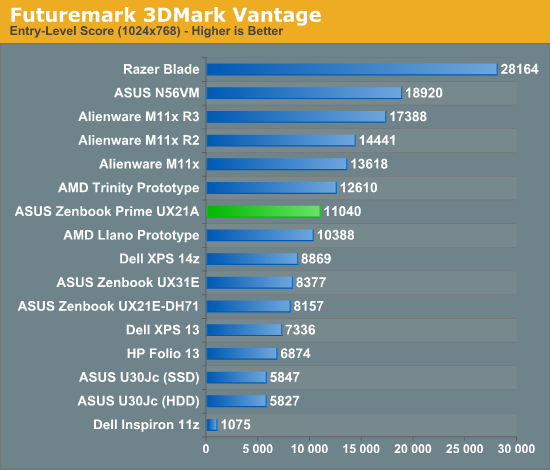
Here we see just how much better Intel's graphics cores have gotten over the years. The Inspiron 11z could barely run the entry level 3DMark Vantage suite, whereas the Zenbook Prime delivers nearly an order of magnitude higher score here.
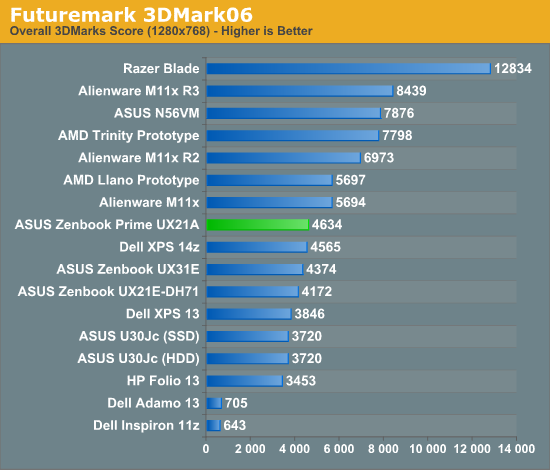
Gaming Performance
We can say that the silicon in the Zenbook Prime's CPU features Intel's HD 4000, the upgraded 16 EU Ivy Bridge GPU. The result should be much improved gaming performance. Once again we are thermally limited so there are some cases where you won't see tremendous increases in performance.
At a high level, for any modern game, you shouldn't count on being able to run it at the Prime's native 1080p resolution. You need a discrete GPU (or Haswell) to pull that off. The former is a tall order for a machine that's already mostly battery. The good news is that 1366 x 768 is playable in many games.
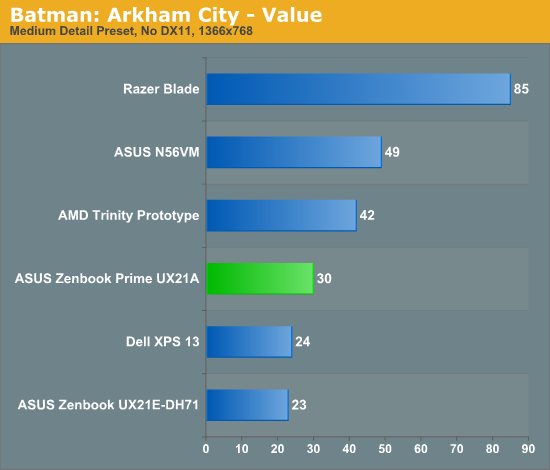
Not all games will see huge performance gains, but the latest Batman title runs 30% quicker on the new Prime.

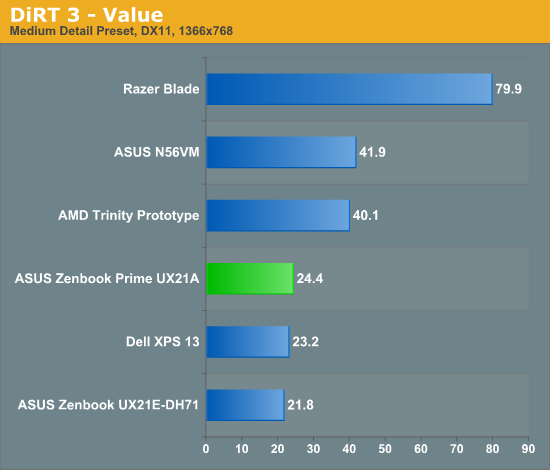
More CPU constrained and thermally bound environments won't show any improvement over the Sandy Bridge based Zenbook UX21.
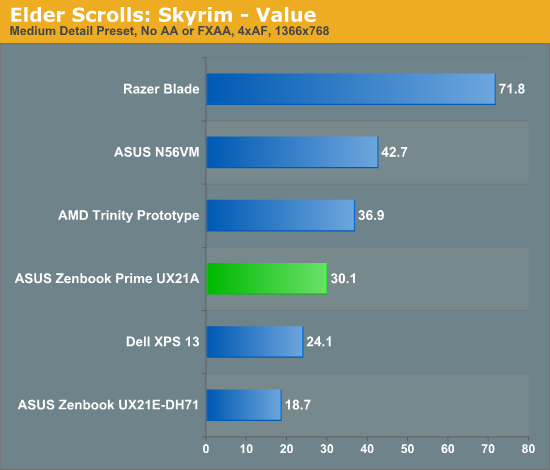
The 61% increase in performance over the original Zenbook takes the Prime into the realm of playability at these settings.

Portal 2 is an interesting case as we are significanty CPU and thermal bound here. The Prime can reach frame rates as high as 39 fps, but after a couple of runs you see degradation into the 32 - 37 fps range. On average, there's no improvement in performance compared to its predecessor - there's no beating the laws of physics.
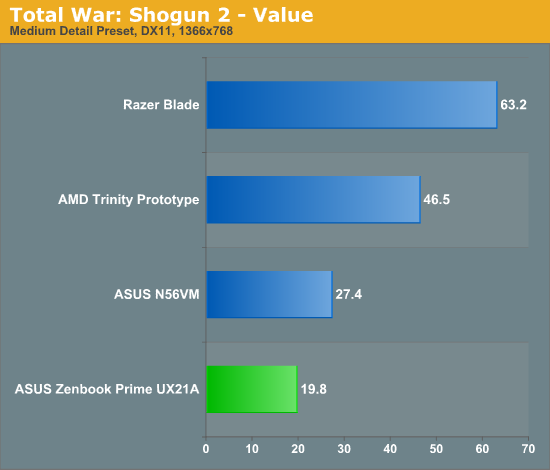
Diablo III
Last week Intel proudly showed me a demonstration of Diablo III running on Ivy Bridge's processor graphics, from a standard notebook all the way down to an Ultrabook. Eager to repeat the experiment myself, I fired up Diablo III on the Zenbook Prime.
Default settings at 1920 x 1080 were understandably unplayable. Dropping the resolution down to 1366 x 768 and clutter density down to medium however gave me an average of around 17 fps outdoors and 20 fps in early crypts. Given that Diablo isn't a twitch shooter, these frame rates were actually playable - all I needed was an external mouse.
As a primary gaming system, any Ultrabook this size is going to fall short. However, if you need to get your Diablo fix in while on the road, the Zenbook Prime will deliver in a pinch.



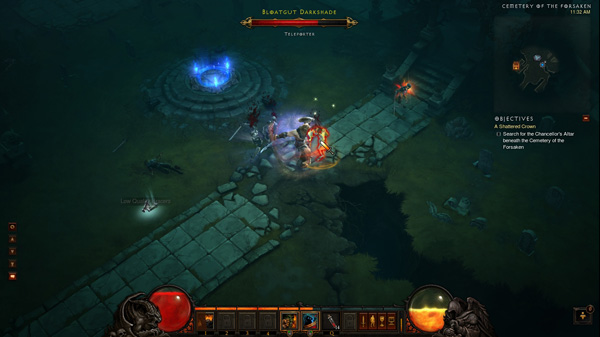








192 Comments
View All Comments
JarredWalton - Wednesday, May 23, 2012 - link
Possibly, though it's NVIDIA hardware and I think GT 620M is just recycled GT 525M or something (Fermi GF108), so it can't do all three. However, it might be able to do internal on the IGP and two external on discrete? Somehow I doubt it, though; the only laptops I've ever seen running more than two simultaneous panels are using AMD GPUs.rosege - Thursday, May 24, 2012 - link
not sure how you count your panels but I have 2 external displays plus the laptop display running on an old X301using a usb to dvi connector for the second external display - you couldnt use it for anything too serious but for general office apps its fine
Penti - Thursday, May 24, 2012 - link
Dell XPS 13 with Ivy Bridge? HP Elitebooks (Elitebook Folio?) with Ivy Bridge? Report back sometime :)We won't find out until later in June I guess.
amalinov - Wednesday, May 23, 2012 - link
Actually there is a way to have what 1ceTr0n wants and keep the ultrasleek design:- fully implemented (micro-)HDMI - that includes CEC and Ethernet, which are optional in the HDMI spec (for CEC you need to add a very small chip - until Intel/AMD/Nvidia start implementing CEC in the GPUs; for Ethernet you need your standard laptop Ethernet controller - Intel, Broadcom or whatever; then you need only a cheep passive cable to use Ethernet)
If I were in ASUS place I would have done also the following about ports:
- fully implemented mini-DisplayPort (instead of the mini-VGA) - that includes CEC and USB2.0 (for CEC you need to add a very small chip - until Intel/AMD/Nvidia start implementing CEC in the GPUs; for USB - just redirect wires from the chipset; USB in Displayport comes in handy for single cable to monitors with integrated USB hubs/cameras, also it can be converted to one additional standard USB port by the use of cheap passive cable - for devices tolerating 3.3V or having their own power supply - such as hubs) - and Thunderbolt as option for 13" premium models
- USB3.0/eSATAp600 combo ports (for the forum skeptics - http://www.delock.de/produkte/F_246_intern_61862/m... is an example of such port) supporting USB Battery Charging 1.2 (7.5W over standard cable) and draft USB Power Delivery (100W over new type of cable) - and remove the power input port (the laptop will be charged by one of the USB PD ports - just like phones are charged by micro-USB currently) - more space for SD card reader or other ports/LEDs/wireless switches
Wireless interfaces I would've added:
- Bluetooth 4.0+HS (over WiFi PHY)+LE (over WiBree PHY)
- NFC
- FM radio with RDS and internal antenna - receiver and transmitter
Options for premium models:
- GPS/GLONASS/Augumentation satellites support; accelerometers, gyroscopes, magnetometer, altimeter - for inertial navigation indoors and other locations with weak satellite signal
- 2G/3G/LTE
- DVB-T/T2/H/SH (or equivalent US TV broadcasts) tuner with internal antenna
Premium models power adapter with:
- additional USB3.0 BatteryCharging/PowerDelivery ports (when the laptop is disconnected those will only provide power to other USB-powered devices; when the laptop-or-another-USB-host is connected a USB3.0 hub in the power adapter will provide also USB connectivity to the connected devices (like a docking station); switch to choose whether the power adapter USB ports should remain powered when no USB host is connected
- maybe integrate the bundled USB-to-Ethernet converter here (but this is kind of redundant if the HDMI port is of the Ethernet-enabled variety)
- maybe also add a USB audio controler providing 6 jack analog jacks (for 7.1 output, line-in, microphone)
Other additions (some of which not very realistic for the time being):
- Anti-glare matte display (if it isn't already of this type)
- Fanless design (if it isn't already of this type)
- Multi-touch screen with support for 10 fingers+2 palm-restings and maybe stylos/handwriting
- Touchpad occupying the whole surface below the keyboard with support for 10 fingers+2 palm-restings and stylos/handwriting; maybe even a second screen (for customizable buttons, auxiliary information like level map, etc.)
- two multi-megapixel back cameras with autofocus, xenon flash, night-mode video illumination, etc. (just like high end phone) for stereoscopic pictures and 2x1080p60 (3D) video
- two 1080p60 front cameras (for 3D mode) - either with separate illumination or utilizing the keyboard illumination
- integrated Kinect-like gesture recognition system with sensors and array microphones
- two picoprojectors on the back (for 3D mode)
Let's hope the above gets implemented in the Haswell (or AMD 28nm) Zenbooks. However, those are not deal breakers (but especially the port section is cheap to do, so kind of expected), so I congratulate ASUS for the Zenbook Prime!
krash3x - Thursday, May 24, 2012 - link
I can see that its kinda pointless to have an ether net port on an ultra portable device but I can also say that sometimes its good to have one. Like trouble shooting connection issues making sure its not something interfering with your wifi or if you want to reduce latency. I have a quick question, how does the display compare to the screen on the new ipad? I'm looking to get something to replace my asus 1201n, and I'm kinda interested in this thing. although it would be nice if it had a dedicated gpu :-/rosege - Thursday, May 24, 2012 - link
this model has dedicated gpuUX32VD-DB71
mcquade181 - Tuesday, May 22, 2012 - link
I agree.The lack of a gigabit ethernet port is a killer. It means copying videos etc from you desktop computer to this will take 10 times as long.
mackintire - Wednesday, May 23, 2012 - link
a gigabit to USB 3.0 adapter will work fine. USB 3.0 is quite a bit faster than gigabit ethernet. Currently we have a DELL XPS13 package for our users that includes the USB 3.0 to gigabit ethernet adapter, they appear to run at full speed transferring 100MB/s with no issues.Sunburn74 - Thursday, May 24, 2012 - link
Thank you for making sense, unlike all these complainers. Most of the additional connectors a person specially needs can be found in the form of adapters and port expanders.Penti - Thursday, May 24, 2012 - link
A Gigabit ethernet adapters as it should also speeds up for USB 2.0 users quite a bit. Easily beets 100Mbit/s any how. Won't do near 1 Gigabit/s however. But it should work as fast as your basic home-user NAS. If you need more you probably has direct attached storage or even fibrelink so :) Nice to see USB 3.0 get native, and yes it's fast enough for most users and are capable to extend things like Ethernet, basic storage.